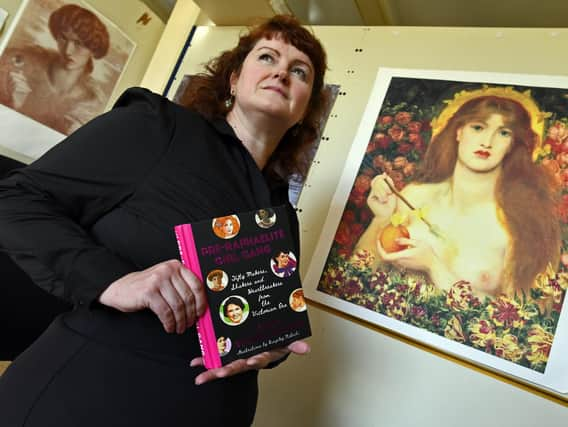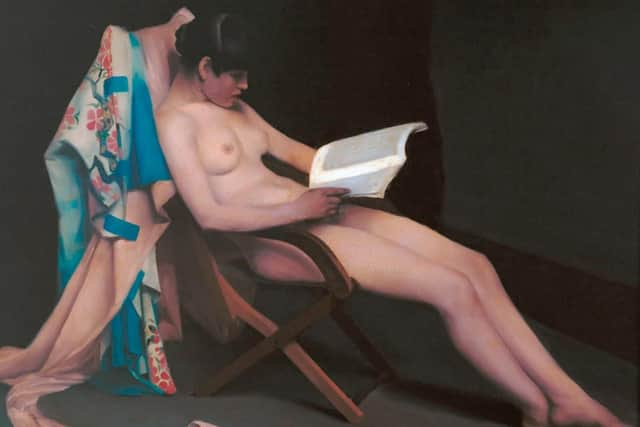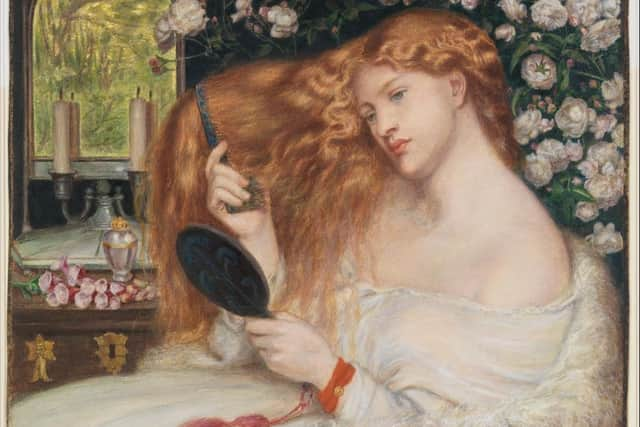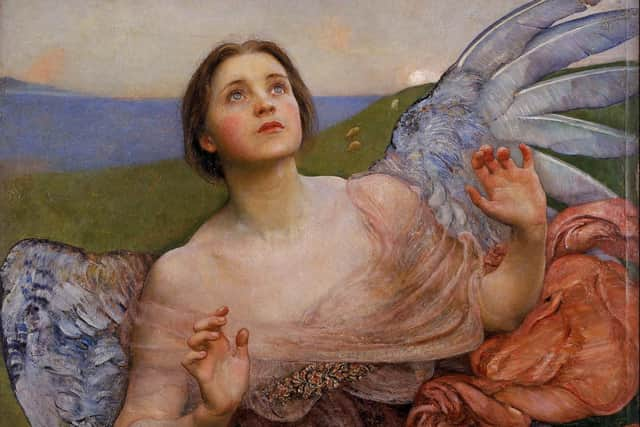Scandalous Portsmouth sisters of the Pre-Raphaelite art movementÂ


Following his death the family were in dire straights.
Fortunately one of the sons had moved to London and befriended members of the Pre-Raphaelite brotherhood, a dazzling mob of artists who were determined to change the art world, and were always on the lookout for pretty young girls to paint.Â
He took three of his '˜troublesome' but beautiful sisters, Hetty, Lily and Rose, to London to work as models for artists.Â


Advertisement
Hide AdAdvertisement
Hide AdThey went down a storm, made some money, broke hearts, and are featured in some of the most important paintings of the era, including An Idyll of 1745, by John Everett Millais.Â
Their rags to riches story is told by historian Kirsty Stonnell-Walker in her new book, Pre-Raphaelite Girl Gang.Â
Kirsty, who works for Historic England at Fort Cumberland, Eastney, has spent 25 years researching the fascinating lives of the female muses and artists involved in the art movement that shocked Victorian England.Â
Kirsty has discovered fascinating tales of 50 women from Portsmouth and beyond whose lives were entwined '“Â and sometimes ruined '“Â by the Brotherhood.Â


Advertisement
Hide AdAdvertisement
Hide AdShe says: '˜Hetty was a Pompey girl, a proud daughter of Portsmouth.
'˜Her brother knew his gorgeous sisters would be perfect models and when he took them back to London with him they went down a bomb. They were snapped up by the most famous artists of the century.'
But they were known for their wilfulness as much as their beauty, causing trouble by only turning up for sittings when they felt like it.
The three Pompey sisters were much like the '˜it'Â girls of today.Â


Advertisement
Hide AdAdvertisement
Hide AdKirsty adds: '˜Hetty did the best out of the sisters, who all modelled for Millais and Edward Burne-Jones.Â
'˜She went on to model for Theodore Roussel, becoming both his mistress and his pupil.
'˜When he finally married another woman, despite having a daughter by Hetty, Hetty took her daughter, her sisters and mother off to live in their own house, independent of any male support.'
Hetty (whose full name was Harriett Selina), was known for her sharp wit and intelligence and proved that women could look after themselves, on their own terms. The most famous of the sisters, she never married and died in 1953.Â
The muses were more infamous, than celebrated.
Advertisement
Hide AdAdvertisement
Hide AdKirsty explains: '˜Hetty posed for The Reading Girl for Roussel which scandalised Victorian society.
'˜It was simply a woman reading a book, in the nude. It was very realistic. There was no pretence, it wasn't idealistic. It was very beautiful.
'˜But society saw women who were models as no different to prostitutes...
'˜Because artists painted fallen women, often people got the models mixed up with the subjects. People assumed the models were prostitutes.'
Advertisement
Hide AdAdvertisement
Hide AdPre-Raphaelite Girl Gang has been a labour of love for Kirsty, who, aside from her life as an author, is a librarian at Historic England, working in the archaeology and architecture department.
She says: '˜My passion began when I did my first degree with the Open University. One of the courses was on Victorian art and music and I was absolutely fascinated.
'˜I hadn't seen anything like it before. It was so bonkers. The women are so recognisable. You can actually spot a woman in one painting and then in another. They painted real people, girlfriends, women they fancied. I'm so passionate about the subject and about getting women's history out there. My daughter has been dragged around art galleries and graveyards all her life.'Â
Kirsty's first book, Stunner: The Fall and Rise of Fanny Cornforth, was published in 2006. It brought Kirsty to international attention when the tale of the sad end to perhaps the most famous '“ and most notorious '“ of the Pre-Raphaelite muses was uncovered.Â
Advertisement
Hide AdAdvertisement
Hide AdAfter years of research Kirsty managed to discover Fanny's demise was in Graylingwell Asylum, Chichester '“Â which has now been turned into a luxury housing development.Â
It was a sad, lingering death for the subject of some of the most beloved paintings of the era and she also features in Girl Gang.Â
'˜The reason I started researching the lives of all these women was Fanny Cornforth, who I first saw in a painting 25 years ago', says Kirsty.Â
'˜She was roundly loathed by her contemporaries, but adored by the painter Dante Gabriel Rossetti who painted her as a flowing-haired temptress.Â
Advertisement
Hide AdAdvertisement
Hide Ad'˜She was born in Sussex, in Steyning near Brighton, but in the last few years of her long life, she ended up in Graylingwell.
'˜Fanny was a bit loud, and a bit common, and people didn't like her.
'˜There seems to be this fascination with how awful she was. People could not stop talking about her. I wanted to know what it was that really fascinated them.'
Working class Fanny was Rossetti's lover for 25 years, she dedicated her life to him.Â
Advertisement
Hide AdAdvertisement
Hide AdBut she was given the cold shoulder by polite society who would not accept her as Rossetti's partner. In the end, she died alone, in Chichester, and almost forgotten until Kirsty uncovered her fascinating story.Â
Pre-Raphaelite Girl Gang is out now, published by Unicorn.
What was the Pre-Raphaelite Brotherhood?Â
The Pre-Raphaelites were a secret society of young artists, poets and writers, founded in London in 1848.Â
The name Pre-Raphaelite Brotherhood referred to the groups' opposition to the Royal Academy's promotion of the Renaissance master Raphael.Â
Inspired by the theories of John Ruskin, who urged artists to '˜go to nature', they believed in maximum realism in their art, as opposed to idealised images.Â
Advertisement
Hide AdAdvertisement
Hide AdIts principal members were William Holman Hunt, John Everett Millais, and Dante Gabriel Rossetti.Â
The scandalous bunch were the subject of the BBC's 2009 drama Desperate Romantics, which starred Poldark star Aiden Turner as Dante Gabrielle Rossetti.Â
Their new style of art, portraying ordinary people, horrified Charles Dickens.Â
The women behind the canvas
Pre-Raphaelite Girl Gang features the female makers and creators as well as the models and muses.Â
Advertisement
Hide AdAdvertisement
Hide AdArtist Annie Swynnerton broke boundaries. Born in 1844, she and her sisters were all artists, but it was Annie who achieved most success.
When her family fell on hard times she started selling her watercolours. They were soon comfortable again and in 1922 Annie became the first female Associate Member of the Royal Academy. No mean feat.Â
Annie retired to Hayling Island where she had a huge studio. When she died aged 89, in 1933, she left 170 works, all but a dozen of them framed.Â
She was buried in St Mary's Churchyard. Kirsty says: '˜Her gravestone reads 'I have known love and the light of the sun', which I think is rather lovely.'
Advertisement
Hide AdAdvertisement
Hide AdAcross the water, on the Isle of Wight, Julia Margaret Cameron was behind the camera.Â
Julia, born 1815, lived at Dimbola Lodge in Freshwater. She started photographing her models (most of whom were her maids) after receiving a camera for her 48th birthday.Â
She was a pioneer, and as well as producing Pre-Raphaelite inspired Biblical and poetic portraits of strong women with long-flowing hair, she also did portraits of the great artists, writers and scientists of the day. Alfred, Lord Tennyson, and Charles Darwin sat for her.Â
She died in 1879.Â
Also on the Isle of Wight was the home of the Spartali family, rich Greek merchants, diplomats and art patrons, and their daughter Marie Spartali who became a famous artist in her own right.